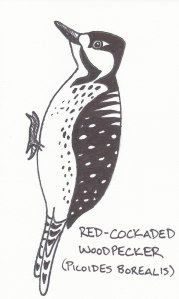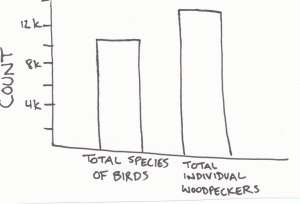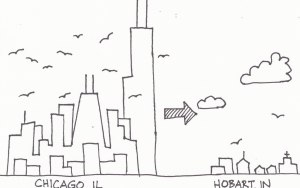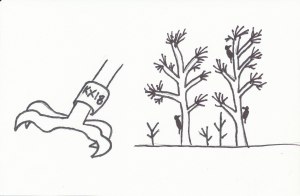Over the 4th of July weekend, Jaime, Walter, and I went to visit my parents in Raleigh. We spent five days in North Carolina, which afforded me a spare morning to drive an hour south to the Weymouth Woods Sandhills Nature Preserve in search of a Red-Cockaded Woodpecker for my life list.
The Red-Cockaded Woodpecker is endemic to the longleaf pine forests of the southeastern United States, being highly specialized to the point of only living in those trees. Unsurprisingly, it is considered rare, although not a conservation poster child like the California Condor or Whooping Crane or even Kirtland’s Warbler.
Different sources cite between 12,000-14,000 Red-Cockaded Woodpeckers living in the entire world, which is only slightly more individual birds than there are total species.
This number represents about 1% of the birds’ historical population. To put that in perspective, imagine the city of Chicago shrinking to the size of Hobart, Indiana.
Being a longleaf pine specialist and choosing only to nest in mature, living trees, the Red-Cockaded Woodpecker has suffered from habitat degradation as its preferred nesting sites have been felled over the years. Today, the birds exist only in scattered pockets of southeastern forest where before they stretched from the Ozarks up the east coast into New Jersey.
Exacerbating the problem are individuals with a misinformed understanding of the role of government in species conservation. Many land owners with prime habitat for the Red-Cockaded Woodpecker have destroyed trees in an attempt to discourage the birds from living on their property, because they believe that if an endangered species is present, the government will take their land or they will be otherwise unable to use it. This was especially a problem in North Carolina close to where my parents live.
Despite all of this, I was able to see a Red-Cockaded Woodpecker on my trip. Since the 1990s, the fortunes of these birds have been increasing thanks to population monitoring and habitat management. Healthy colonies even exist on private land.
I searched for about four hours before finding just one woodpecker, even though I was at a site well-known for these birds. In the mean time I had ample time to think about exactly what it was that I was seeking out. I keep a numbered list of the species I have seen, but sometimes it is better to appreciate what’s there just for its own sake.






